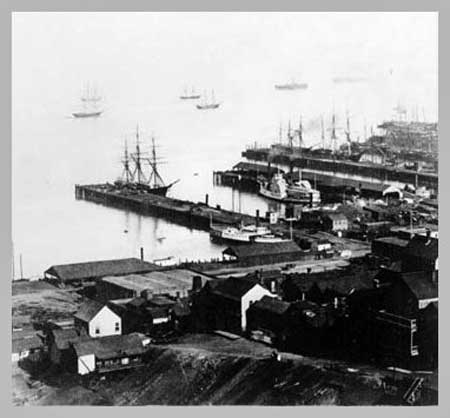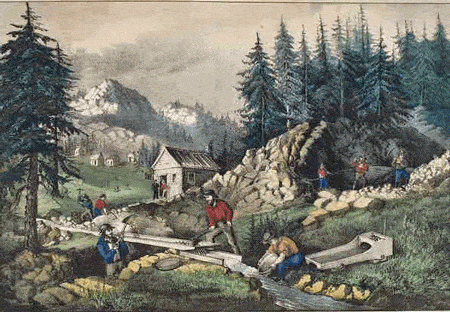
Picture from Guide Lines News Letter
By Bill Wells
European Settlement
The Mexican Government surely became concerned about the interlopers ferreting around in their territory and it is believed that this is what led them to grant John Sutter his vast tract at the confluence of the Sacramento and American Rivers. One of Sutter’s boats was the schooner Isabella which legend has it had been the private yacht of King Kamehameha the Great of the Sandwich Islands, possibly the first yacht in the Delta! Leaving what is now San Francisco in August of 1839 it took Sutter and his band eight days to find the entrance to the Sacramento after passing through Carquinez Straits which speaks to the maze of waterways even then. Sutter eventually landed on the bank of the American River at about where the city dump of Sacramento is located. He built his fort nearby at what is now the corner of 27th and L streets in Sacramento. Sutter became a Mexican citizen on August 29, 1840 and was appointed Captain in the Mexican Army as well as judge and representative of the “Government at the Frontier of the Rio Sacramento”. Sutter’s treatment of the Indians is a matter of controversy. Certainly he treated them no worse than did the Mexicans or the Spanish before them. What is known is that he minted tin coins with stars stamped into them for payment to the Indians for work performed and the coins could be redeemed later for food or dry goods in Sutter’s store.
Charles Weber migrated westward and arrived at John Marsh’s ranch at the base of Mt. Diablo in October of 1841. Weber made his way to Sutter’s fort and was employed there in the winter of 1841. Sutter sponsored Weber to obtain Mexican citizenship, which made Weber eligible to receive a land-grant from Mexico. In 1844 Captain Charles Weber and William Gulnac obtained a Mexican land grant for the Rancho del Campo de los Franceses of about 48,000 acres. Weber later bought out Gulnac for $200 and started the settlement of Slough Town later renamed Tuleburg.
During the Mexican-American war the Mexicans imprisoned Weber for refusing to raise arms against the Americans. Commodore Robert F. Stockton the American military commander of California rescued him. In gratitude Weber renamed his settlement Stockton which name it still bears today. The Steamer John A. Sutter was the first power boat to arrive in Stockton on November 1849.
On June 16, 1846 the settlers in California under the command of John Fremont declared independence from Mexico and created the Bear Flag Republic. On July 11, 1846 Paul Revere’s nephew Lieutenant Joseph Revere sent a United States flag to Sutter and the U.S. annexed California under the Treaty of Guadalupe Hidalgo which included paying Mexico a cash payment of $15,000,000 and the United States assuming claims of American citizens against Mexico of $3,250,000. This ended Mexico’s 21 year control of California. On September 9, 1850, by act of congress California became the 31st state in the Union.
Gold!

In January of 1848 James Marshall found gold at Sutter’s sawmill on the American River at Coloma and the news quickly spread to San Francisco in spite of Sutter’s attempt to keep the discovery secret. The first known newspaper account was on March 15, 1848 in The Californian in San Francisco and from then on the population of Northern California grew exponentially.
Sam Brannan seized the opportunity and opened a store selling mining supplies. Sam is credited with founding the city of Sacramento and was rumored to have been seen running through the streets of San Francisco yelling “gold has been discovered in the Sierras!” Brannan was reported as California’s first millionaire. John Sutter later in 1848 said:”Every little shanty in or around the Fort became a store, a warehouse or a hotel, the whole settlement was a veritable bazaar.”
Captain William Warner and Lieutenant William T. Sherman (later as General Sherman of Civil War fame) surveyed the area between Sutter’s Fort and the Embarcadero along the Sacramento River laying out the first grid of the city that would be known as “Sacramento City”. Sam Brannan claimed credit for the name. From Sherman’s memoirs: “ Having finished our work on the Cosumnes, we proceeded to Sacramento, where Captain Sutter employed us to connect the survey of Sacramento City, made by Lieutenant Warner, and that of Sutterville, three miles below, which was then being surveyed by Lieutenant J. W. Davidson, of the First Dragoons. At Sutterville, the plateau of the Sacramento approached quite near the river, and it would have made a better site for a town than the low, submerged land where the city now stands; but it seems to be a law of growth that all natural advantages are disregarded wherever once business chooses a location. Old Sutter’s embarcadero became Sacramento City, simply because it was the first point used for unloading boats for Sutter’s Fort”
Originally the San Joaquin had a myriad of turns and bends and plans to straighten it were formulated in the 1870’s. The project was finished in the 1930’s by cutting through numerous islands and dredging the channel to 26 feet. This one project created many new islands and meandering waterways that are still in existence today.
John Bidwell had a 17,700 acre land grant along the Sacramento River starting in 1844 that included the area that now is the City of Rio Vista. In 1848 at the beginning of the gold rush a wharf was built to handle the steamer traffic. N.H. Davis purchased the town site from Bidwell in 1855 and by 1860 the town was called Rio Vista. The great storm of 1861 washed the town away and it was later rebuilt on higher ground where it remains today. The channel of the Sacramento river originally went through horseshoe bend to the east of Decker Island just downstream from Rio Vista but a cut was made and the channel moved to its present location in 1918 creating Decker Island.
Up until the rivers were silted in by hydraulic mining in the 1870’s steamers could make it all the way up the Sacramento to Red Bluff and up the Feather River as far as Yuba City. On the San Joaquin steamers made it as far as Firebaugh near Fresno. There are even records of steamboats going as far as Coloma (!) on the American River. The hydraulic mining caused terrible silting of the rivers, which is still a major problem today. The Yuba river near Marysville went from a “fish filled 30-foot (deep) water” in 1850 to where “the river was almost level with Marysville streets” in 1878 according to Marysville mayor at that time C.E. Stone. The Briggs orchard near Marysville was covered with 20 feet of silt. In one year in the 1870’s “46 Million cubic yards of gravel, a mass a mile wide and a mile long and fifteen yards deep had been hurled into the streams or spread over the farm lands”. Over a thirty year period two billion cubic yards of debris filled the Sacramento River and its tributaries.
The gold rush brought hoards of people to Northern California. Some came overland but many came by sea. As of March of 1850 Sacramento City had thirty stores, six saloons, and many other business establishments. By 1855 Sacramento produced $300,000 worth of manufactured items per month.
The name of the settlement of Yerba Buena was changed to San Francisco in 1847. The original settlement was started at Yerba Buena Cove but as the population and area expanded a new name was thought to be in order. Gold captivated most people until about 1860 at which time agriculture was rediscovered. The original farmers were called rimlanders because they farmed on the edges of the Delta before the islands had been surrounded with levees and reclaimed.
Source:
Bill Wells
Executive Director
California Delta Chambers & Visitor’s Bureau
PO Box 1118
Rio Vista, CA 94571
916-777-4041
Click Here for California Delta Chambers Website
For all your real estate needs call or write:
John J. O’Dell
Real Estate Broker
O’Dell Realty
(530) 263-1091